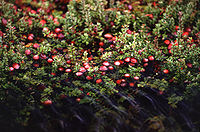
Photo from wikipedia
Nutrient treatment performance of stormwater best management practices (BMPs) is highly variable. Improved nutrient management with BMPs requires a better understanding of factors that influence stormwater BMP treatment processes. We… Click to show full abstract
Nutrient treatment performance of stormwater best management practices (BMPs) is highly variable. Improved nutrient management with BMPs requires a better understanding of factors that influence stormwater BMP treatment processes. We conducted a meta-analysis of vegetated BMPs in the International Stormwater BMP Database and compared influent and effluent nitrogen and phosphorus concentrations to quantify the BMP effect on nutrient management across climates. BMP effect on nutrient concentration change was compared between vegetated BMPs in wet and dry climates. We examined paired dissolved inorganic nitrogen (DIN), total nitrogen (TN), dissolved inorganic phosphorus (DIP), total phosphorus (TP), and combinations of these analytes as dissolved inorganic ratios and N:P ratios. Meta-analysis with subgroup analysis was used to determine differences between wet and dry climates and among vegetated BMP types. We found that across both wet and dry climates, BMPs leach DIP and TP, increase the fraction of dissolved inorganic P (DIP:TP), and decrease dissolved N:P ratios. Dry-climate BMPs leach DIP and TP more consistently and at a higher magnitude than wet-climate BMPs, and bioretention leaches more DIP than grass strips and swales. These findings generally align with biogeochemical cycling, differences in influent chemistry, and BMP design types and goals.
Journal Title: Environmental science & technology
Year Published: 2023
Link to full text (if available)
Share on Social Media: Sign Up to like & get
recommendations!